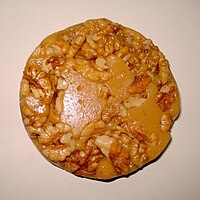|
Sohan halwa
Sohan halwa (Urdu سوہن حلوہ; [ˈsoːɦən ˈɦəlʋaː]) is a traditional Mughlai[1] dessert from Punjab, popular in the Indian subcontinent, which is a variety of dense, sweet confection or halwa. Gheewala halwa is popular for sohan halwa since the Mughal era.  It is made by boiling a mixture of water, sugar, milk, and cornflour until it becomes solid. Saffron is used for flavoring. Ghee is used to prevent it from sticking to the pan. Almonds, pistachios, and cardamom seeds are added. Unlike most other halwa dishes in the Indian subcontinent, it is solid, similar to its Middle Eastern counterparts. Sohan Halwa is a very important part of Pakistani cuisine, particularly Saraiki cuisine. One of its varieties, known as Multani or Hafiz Sohan Halwa, is very popular in Pakistan and among Pakistani diaspora across the globe. History In Old Delhi, in 1790, a Ghantewala sweet shop established during the reign of Mughal Emperor Shah Alam II made sohan halwa. It was a popular attraction,[2][3] but in 2015 it closed due to a lack of profitability.[4] This sweet was originally called sohan in Khariboli (Hindi). The name is etymologically derived from the Sanskrit word shobhan[citation needed]. According to John T. Platts' Dictionary of Urdu, Classical Hindi and English, the sweet was named after one Sohan Lal.[5] Commercial productionSohan halwa has been commercially produced by traditional confectioners for decades. It is brittle and caramelised, usually made into discs of 5-6mm thickness or as square bite-size pieces. It is usually packaged in intricately designed tin cylinders. In recent years other packages have also been common.[6] See alsoReferences
|
||||||||||||||

